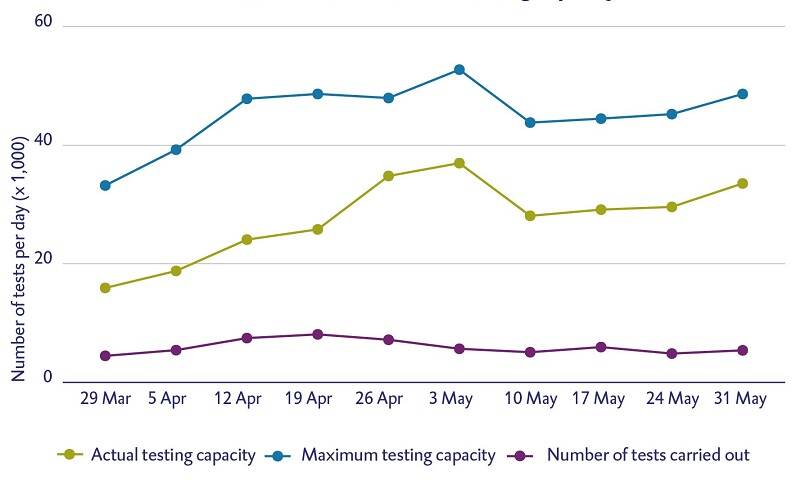Testing capacity went unused in the spring
Investigation of corona crisis measures
More people could probably have been tested for novel coronavirus in the first months of the outbreak. Testing equipment was in short supply but full use was not made of the available laboratory capacity. The Netherlands Court of Audit presents these findings in a report on its investigation of testing capacity in the period up to 1 June 2020.

Testing capacity and measures to scale it up came under pressure from several factors in the spring. Transport restrictions and the surge in international demand, for instance, reduced the supply of testing equipment. Laboratories usually do not hold large stocks of such equipment. The testing system is only as strong as its weakest link. Lack of cotton swabs to take tests, for instance, can bring down the entire system. Municipal health services, moreover, did not have the capacity or financial resources necessary to meet the rapid increase in demand for corona tests and the related track and trace work.
Shortages
The pandemic initially spread very unevenly across the Netherlands. Some regions were in danger of running out of laboratory capacity and testing equipment within a week, while others did not experience shortages for a month. By contrast, a handful of laboratories did not suffer any shortage of testing equipment throughout the period investigated. Laboratories that worked with several suppliers were less likely to suffer shortages than those that relied on a single supplier.
No national oversight
In the period up to the end of March, the Ministry of Health, Welfare and Sport (VWS) and the National Institute for Public Health and the Environment (RIVM) did not know how much testing capacity was available at laboratories or what equipment they had in stock. This is commercially sensitive information held by private parties. The RIVM is not responsible for it and does not include it in the scaling-up plan it implements for epidemics.
It proved both difficult and time consuming for the Ministry of VWS to gain an understanding of the available laboratory capacity, the specific shortages and projected future testing requirements.
Cautious testing policy
With both testing equipment and testing capacity at risk, the Outbreak Management Team recommended that tests for novel Coronavirus should be carried out on a modest scale. The government agreed and followed its advice. Testing policy was based on available national laboratory capacity so that target groups would not be let down and regular care providers would not be put at risk.
More testing equipment for countries with a less cautious testing policy
The Court of Audit also found that the scaling-up of testing capacity was hampered by international suppliers estimating each country’s demand for equipment. As their estimates were based on national testing policies, they supplied more equipment to countries with less cautious testing policies. They also wanted to prevent scarce equipment being hoarded.
More tests were probably possible
More tests could probably have been carried out during the period investigated. The reasons why they were not are relevant with a view to a possible second corona wave this autumn.
- Some regions could have tested more people in the target groups. However, in the period up to 1 June the national policy took no account of regional differences in the availability of tests and demand for them.
- In hindsight, fewer care providers and other target groups were tested than the Ministry of VWS and the RIVM had estimated.
- Demand for routine care unexpectedly fell sharply in March, releasing more laboratory capacity. This, too, had not been foreseen.
- The municipal health services followed the guidelines on who was eligible for testing and who was not more strictly than the national policy required.
Number of tests carried out was lower than the testing capacity

The figure above shows that fewer tests were carried out in the period up to 1 June than could have been given the available laboratory capacity. The maximum testing capacity (blue line) is an estimate of what the laboratories could have done if there had been no shortages of testing equipment. In practice, the laboratories tended to overestimate their actual testing capacity because they did not allow for supply problems. Furthermore, the number of tests they were able to carry out was reduced by operational inefficiencies and quality controls. The available number of tests was therefore lower than the actual testing capacity reported by the laboratories. Even if these factors are taken into account, however, the testing capacity in the period up to 1 June was higher than the number of tests carried out. It is not possible to calculate how any more people could have been tested.
The Netherlands Court of Audit hopes this investigation will help the government and parliament learn the full lessons of how the testing system and the government’s decision-making could have been improved in the spring. The investigation was carried out faster than initially planned as there may be a second corona wave in the autumn. It is one in a series of investigations of the Dutch government’s response to the corona crisis